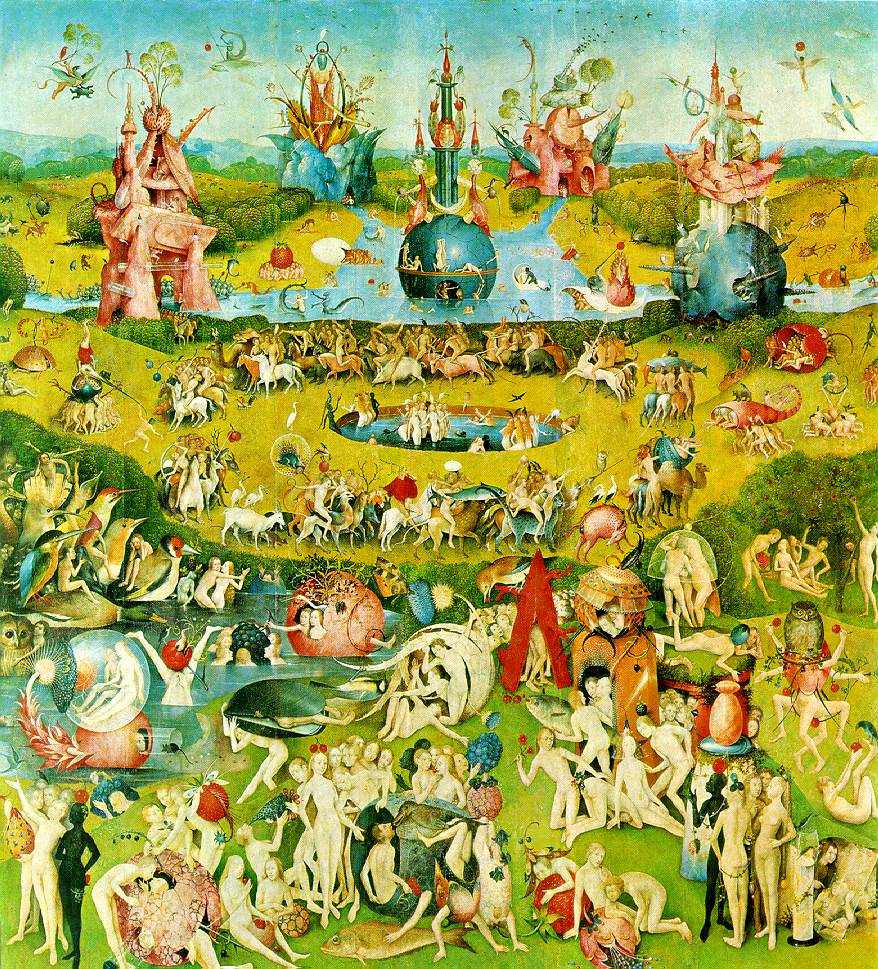 The first thing I thought of when I read about Garden of Earthly Delights by Hieronymus Bosch and The Temptation of Saint Anthony by Martin Schongauer was SURREALISM!!!
The first thing I thought of when I read about Garden of Earthly Delights by Hieronymus Bosch and The Temptation of Saint Anthony by Martin Schongauer was SURREALISM!!!Could it be that Bosch and Schongauer were the grandfathers of Surrealism? Is it possible the Dali and Ernst got their inspiration from these two masters? There are many more similarities in their collective works than there are similarities to Bosch’s and Schongauer’s predecessors of 14th C Italy. Yes, we see the representation of a biblical scene or story, but how each is portrayed departs completely from past executions. In the Garden, we see a collection of nudes, in unexplainable acts, accompanied by fantastical and bizarre objects; never before have we seen this many nudes collected in one painting let alone portrayed as there are surrounded by this strange environment. The most striking resemblance to Dali is the use of bizarre objects; half-human, half-? Egg? Stone? Are some flying? Suspended? This fantastical oil painting harkens back to Lorenzetti’s Peaceful City and Country in two respects. First, colorization, here we see the same use of bright, vibrant colors (on the center panel especially). However, the left and the right panels, and their use of dark, deep colors makes me think that Dali and Bosch had their easels set side-by-side when these were painted. The use of shadow is very foreboding and adds a level of mystery and anticipation. Second, the use of landscape, like Lorenzetti, we see a wonderful attempt at space definition through the use of one-point perspective.
 Schongauer’s Temptation surrounds Saint Anthony with fantastical beasts; a theme often times represented in the works of Surrealist masters. The use of hatching and hard, defined contour lines, in this print, defines his figures in a swirl of violent activity. Again, ala Dali and even Bosch, we see front and center hybrid animals. Clearly Schongauer wanted to drive home the symbolic natural of a hellish afterlife. How else can you explain a 15th C artist “dreaming up” figures and action like this? Shadowing, in this case done through minute hatching adds to the image’s dark and ominous symolism. How do we compare this to 14th C Italy? Attention to detail and individualization—but that’s it. Nowhere in the past do we see such violence, terror, and creatures as in the Temptation.
Schongauer’s Temptation surrounds Saint Anthony with fantastical beasts; a theme often times represented in the works of Surrealist masters. The use of hatching and hard, defined contour lines, in this print, defines his figures in a swirl of violent activity. Again, ala Dali and even Bosch, we see front and center hybrid animals. Clearly Schongauer wanted to drive home the symbolic natural of a hellish afterlife. How else can you explain a 15th C artist “dreaming up” figures and action like this? Shadowing, in this case done through minute hatching adds to the image’s dark and ominous symolism. How do we compare this to 14th C Italy? Attention to detail and individualization—but that’s it. Nowhere in the past do we see such violence, terror, and creatures as in the Temptation.Cited Websites
http://www.ibiblio.org/wm/paint/auth/bosch/
http://www.museodelprado.es/en/ingles/collection/on-line-gallery/on-line-gallery/obra/the-garden-of-earthly-delights/
http://www.britishmuseum.org/explore/highlights/highlight_objects/pd/m/martin_schongauer,_the_temptat.aspx
http://0-www.oxfordartonline.com.library.pcc.edu/subscriber/article/grove/art/T076738pg1?q=schongauer%2C+martin&search=quick&pos=1&_start=1#firsthit
Salivadore Dali’s work:
http://www.infj.ulst.ac.uk/~jcaug/dalitime.htm
Max Ernst Sampling and Short Bio
http://www.mcs.csuhayward.edu/~malek/Ernst.html
No comments:
Post a Comment